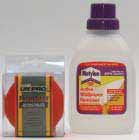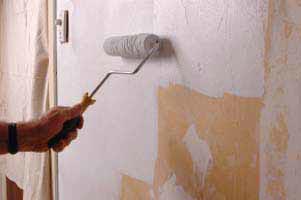Resene Popular Paint Systems – painting interior walls: training notes

This web page is an edited version of the Resene Best System Selling training notes provided to Resene staff and is provided to enable you to gain a greater understanding of the substrates and paint systems you may encounter in your decorating project. It is impossible to cover all decorating scenarios in a single document, so if you are in doubt about any aspect of your project please contact Resene for assistance.
Select the wall surface you will be painting from the list below to view how to prepare and finish the surface.
Preparation flowcharts
Room flowcharts
Scour the wall using a Paper Tiger Wallpaper Stripper
Wet the area you are stripping thoroughly, about 5-6m2 at a time using Metylan Wallpaper Remover. Work from the bottom to the top.
Using a flat bladed scraper, remove the damp paper
Apply Resene Moss & Mould Killer if the substrate has mould spores present
Sand with 100 grit zinc stearate sandpaper
Fill any holes, dents and cracks using Selleys Rapid Filla and lightly sand with 220 grit zinc stearate sandpaper
Apply Resene Sureseal
Apply Resene Broadwall Surface Prep – consider a second application if the wall is severely dented or damaged
Sand using 220 grit zinc stearate sandpaper
Refer to room flow charts


Wallpaper manufacturers recommend that paperfaced plasterboard walls are sealed with Resene Sureseal before the wallpaper is hung to enable walls to be stripped more easily at a later date although this good advice is not always followed. Wallpaper is often hung over the top of previous papers making stripping more difficult and time consuming.
Mix the Metalyn and warm water and apply using a brush (a household brush will be fine) and/or a garden sprayer.

The key is to ensure the wallpaper is thoroughly soaked with the stripper. Cuts made by the Paper Tiger allow the mixture to penetrate the paper (and layers of paper) more easily.
Lay old towels against the skirting board to prevent moisture entering the carpet. You will need to be especially careful if using Resene Moss & Mould Killer as any spills, splashes or drips will bleach the towels and carpet.
Use a combination of a 75mm broad knife scraper and a 25mm scraper for corners and difficult to remove areas.
Areas where plaster has been used to fix holes etc on old wallpaper are very difficult to remove. Once the paper is removed the surface will be less than perfect and holes and gouges caused by the scrapers will need to be filled.

The walls will need sealing and as some glues, moisture and even the aged paperfaced plasterboard may stain through a waterborne system, always use Resene Sureseal.
You can then use Resene Broadwall Surface Prep to improve the surface before painting. This may require a second coat.
Steam strippers are available for hire. If you have large areas to strip you should consider this option.
We have an arrangement with Hirequip (in NZ) allowing Resene customers to receive a 10% discount on the hireage charge upon presentation of their Resene DIY card.